Contract Law and Tort Principles
VerifiedAdded on 2020/01/28
|13
|4852
|130
Essay
AI Summary
This assignment delves into core principles of contract law and tort. It examines concepts such as lawful consideration, breach of contract, and volenti-non-fit-injuria within the context of legal precedents and academic literature. The assignment utilizes case studies, legal texts, and scholarly articles to provide a thorough analysis of these fundamental legal principles.
Contribute Materials
Your contribution can guide someone’s learning journey. Share your
documents today.
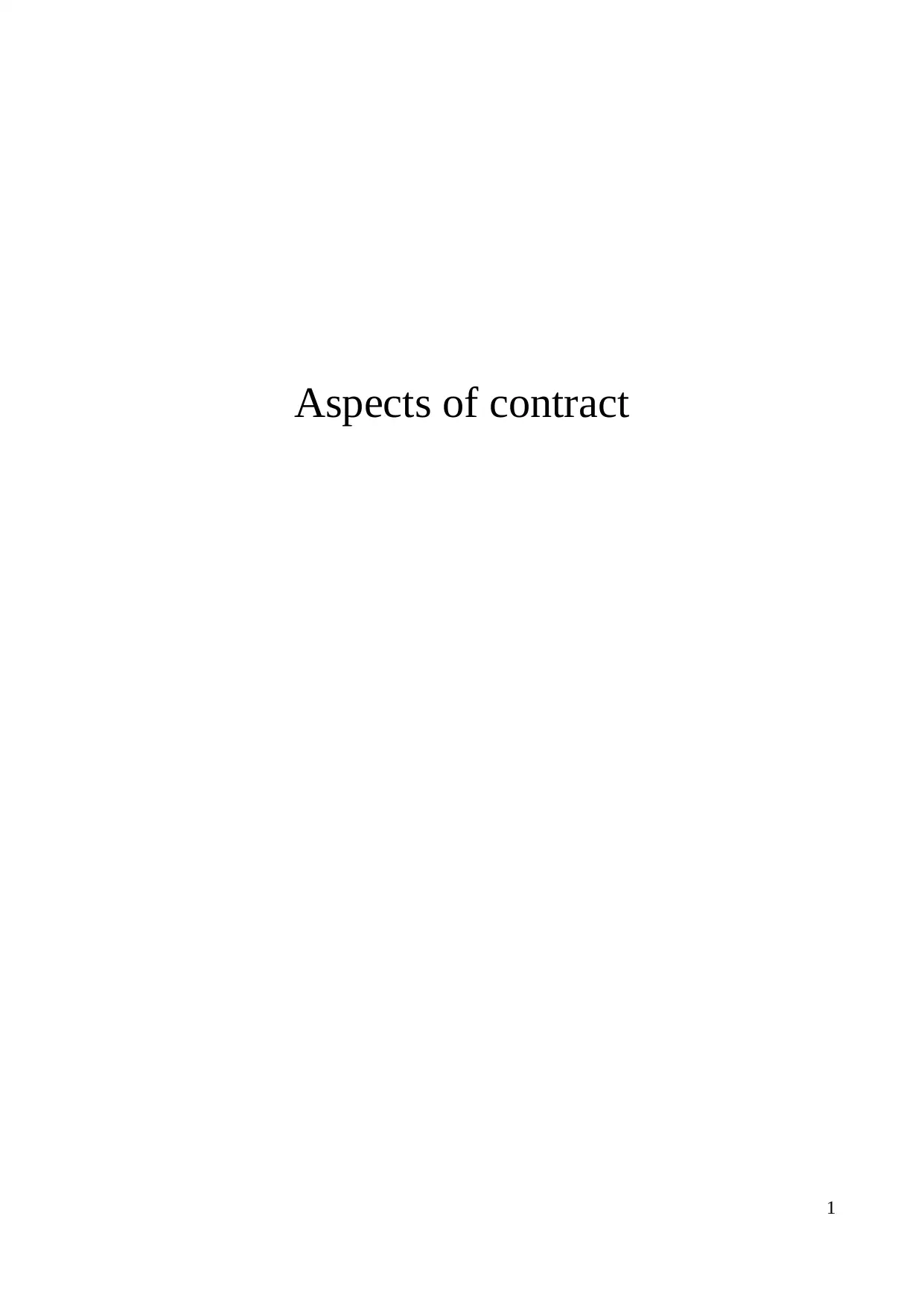
Aspects of contract
1
1
Secure Best Marks with AI Grader
Need help grading? Try our AI Grader for instant feedback on your assignments.

Table of Contents
INTRODUCTION................................................................................................................................3
TASK 1.................................................................................................................................................3
1. Explaining the importance of essential elements of a contract....................................................3
2. Discussing the impact of various types of contract.....................................................................4
3. Analysing contractual terms with references to their meaning & effects....................................5
4. Apply the elements of contracts in the given business scenario..................................................6
5. Applying the law on terms in various types of contracts.............................................................7
6. Evaluating the effect of different terms in a given contract.........................................................7
TASK 2.................................................................................................................................................8
1. Differentiating liability in tort with the contractual liability.......................................................8
2. Explaining the nature of liability in negligence...........................................................................9
3. Explaining how a business can be vicariously liable...................................................................9
4. Applying the elements of tort of negligence, vicarious liability & defences.............................10
CONCLUSION...................................................................................................................................11
REFERENCES...................................................................................................................................12
2
INTRODUCTION................................................................................................................................3
TASK 1.................................................................................................................................................3
1. Explaining the importance of essential elements of a contract....................................................3
2. Discussing the impact of various types of contract.....................................................................4
3. Analysing contractual terms with references to their meaning & effects....................................5
4. Apply the elements of contracts in the given business scenario..................................................6
5. Applying the law on terms in various types of contracts.............................................................7
6. Evaluating the effect of different terms in a given contract.........................................................7
TASK 2.................................................................................................................................................8
1. Differentiating liability in tort with the contractual liability.......................................................8
2. Explaining the nature of liability in negligence...........................................................................9
3. Explaining how a business can be vicariously liable...................................................................9
4. Applying the elements of tort of negligence, vicarious liability & defences.............................10
CONCLUSION...................................................................................................................................11
REFERENCES...................................................................................................................................12
2
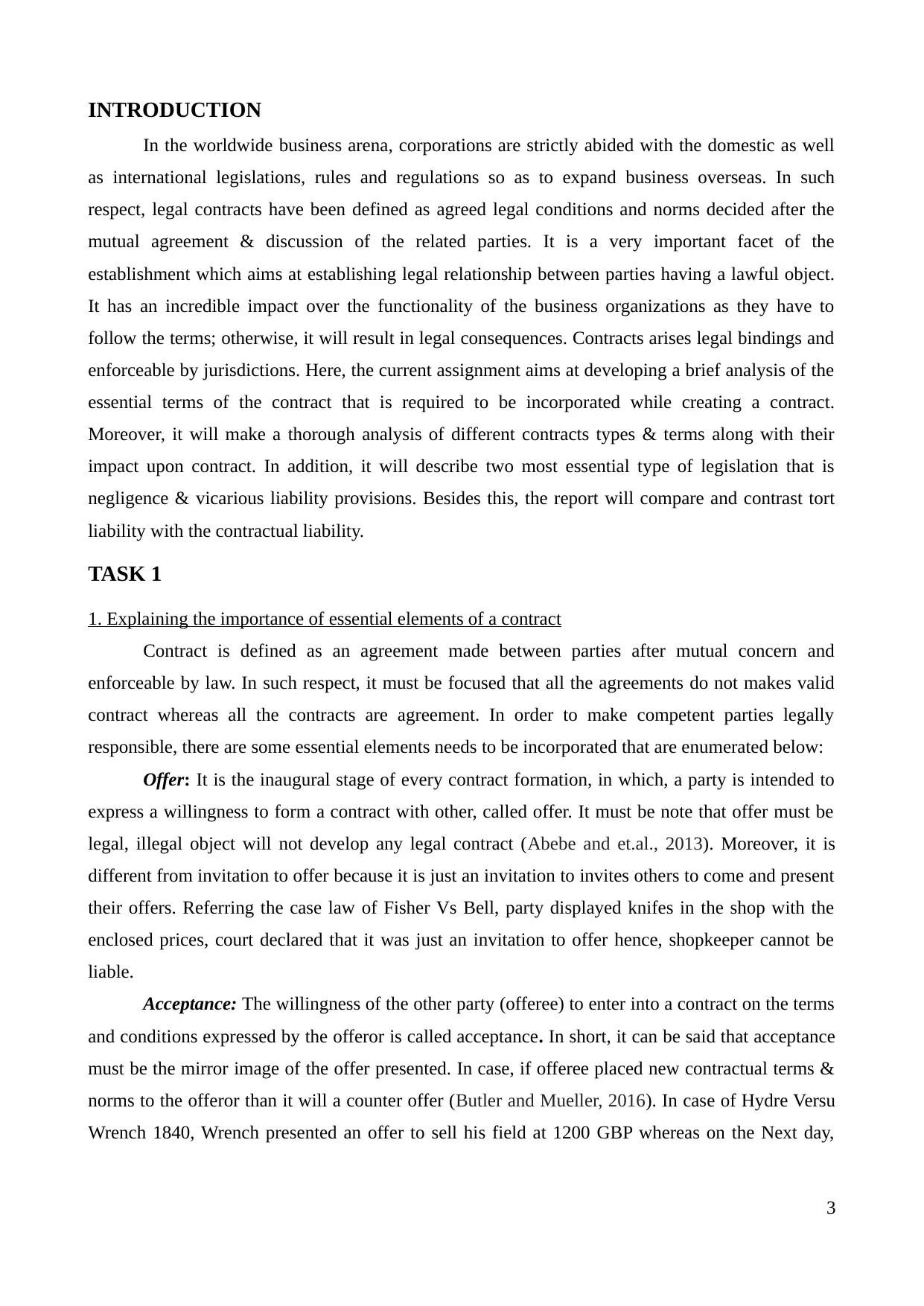
INTRODUCTION
In the worldwide business arena, corporations are strictly abided with the domestic as well
as international legislations, rules and regulations so as to expand business overseas. In such
respect, legal contracts have been defined as agreed legal conditions and norms decided after the
mutual agreement & discussion of the related parties. It is a very important facet of the
establishment which aims at establishing legal relationship between parties having a lawful object.
It has an incredible impact over the functionality of the business organizations as they have to
follow the terms; otherwise, it will result in legal consequences. Contracts arises legal bindings and
enforceable by jurisdictions. Here, the current assignment aims at developing a brief analysis of the
essential terms of the contract that is required to be incorporated while creating a contract.
Moreover, it will make a thorough analysis of different contracts types & terms along with their
impact upon contract. In addition, it will describe two most essential type of legislation that is
negligence & vicarious liability provisions. Besides this, the report will compare and contrast tort
liability with the contractual liability.
TASK 1
1. Explaining the importance of essential elements of a contract
Contract is defined as an agreement made between parties after mutual concern and
enforceable by law. In such respect, it must be focused that all the agreements do not makes valid
contract whereas all the contracts are agreement. In order to make competent parties legally
responsible, there are some essential elements needs to be incorporated that are enumerated below:
Offer: It is the inaugural stage of every contract formation, in which, a party is intended to
express a willingness to form a contract with other, called offer. It must be note that offer must be
legal, illegal object will not develop any legal contract (Abebe and et.al., 2013). Moreover, it is
different from invitation to offer because it is just an invitation to invites others to come and present
their offers. Referring the case law of Fisher Vs Bell, party displayed knifes in the shop with the
enclosed prices, court declared that it was just an invitation to offer hence, shopkeeper cannot be
liable.
Acceptance: The willingness of the other party (offeree) to enter into a contract on the terms
and conditions expressed by the offeror is called acceptance. In short, it can be said that acceptance
must be the mirror image of the offer presented. In case, if offeree placed new contractual terms &
norms to the offeror than it will a counter offer (Butler and Mueller, 2016). In case of Hydre Versu
Wrench 1840, Wrench presented an offer to sell his field at 1200 GBP whereas on the Next day,
3
In the worldwide business arena, corporations are strictly abided with the domestic as well
as international legislations, rules and regulations so as to expand business overseas. In such
respect, legal contracts have been defined as agreed legal conditions and norms decided after the
mutual agreement & discussion of the related parties. It is a very important facet of the
establishment which aims at establishing legal relationship between parties having a lawful object.
It has an incredible impact over the functionality of the business organizations as they have to
follow the terms; otherwise, it will result in legal consequences. Contracts arises legal bindings and
enforceable by jurisdictions. Here, the current assignment aims at developing a brief analysis of the
essential terms of the contract that is required to be incorporated while creating a contract.
Moreover, it will make a thorough analysis of different contracts types & terms along with their
impact upon contract. In addition, it will describe two most essential type of legislation that is
negligence & vicarious liability provisions. Besides this, the report will compare and contrast tort
liability with the contractual liability.
TASK 1
1. Explaining the importance of essential elements of a contract
Contract is defined as an agreement made between parties after mutual concern and
enforceable by law. In such respect, it must be focused that all the agreements do not makes valid
contract whereas all the contracts are agreement. In order to make competent parties legally
responsible, there are some essential elements needs to be incorporated that are enumerated below:
Offer: It is the inaugural stage of every contract formation, in which, a party is intended to
express a willingness to form a contract with other, called offer. It must be note that offer must be
legal, illegal object will not develop any legal contract (Abebe and et.al., 2013). Moreover, it is
different from invitation to offer because it is just an invitation to invites others to come and present
their offers. Referring the case law of Fisher Vs Bell, party displayed knifes in the shop with the
enclosed prices, court declared that it was just an invitation to offer hence, shopkeeper cannot be
liable.
Acceptance: The willingness of the other party (offeree) to enter into a contract on the terms
and conditions expressed by the offeror is called acceptance. In short, it can be said that acceptance
must be the mirror image of the offer presented. In case, if offeree placed new contractual terms &
norms to the offeror than it will a counter offer (Butler and Mueller, 2016). In case of Hydre Versu
Wrench 1840, Wrench presented an offer to sell his field at 1200 GBP whereas on the Next day,
3
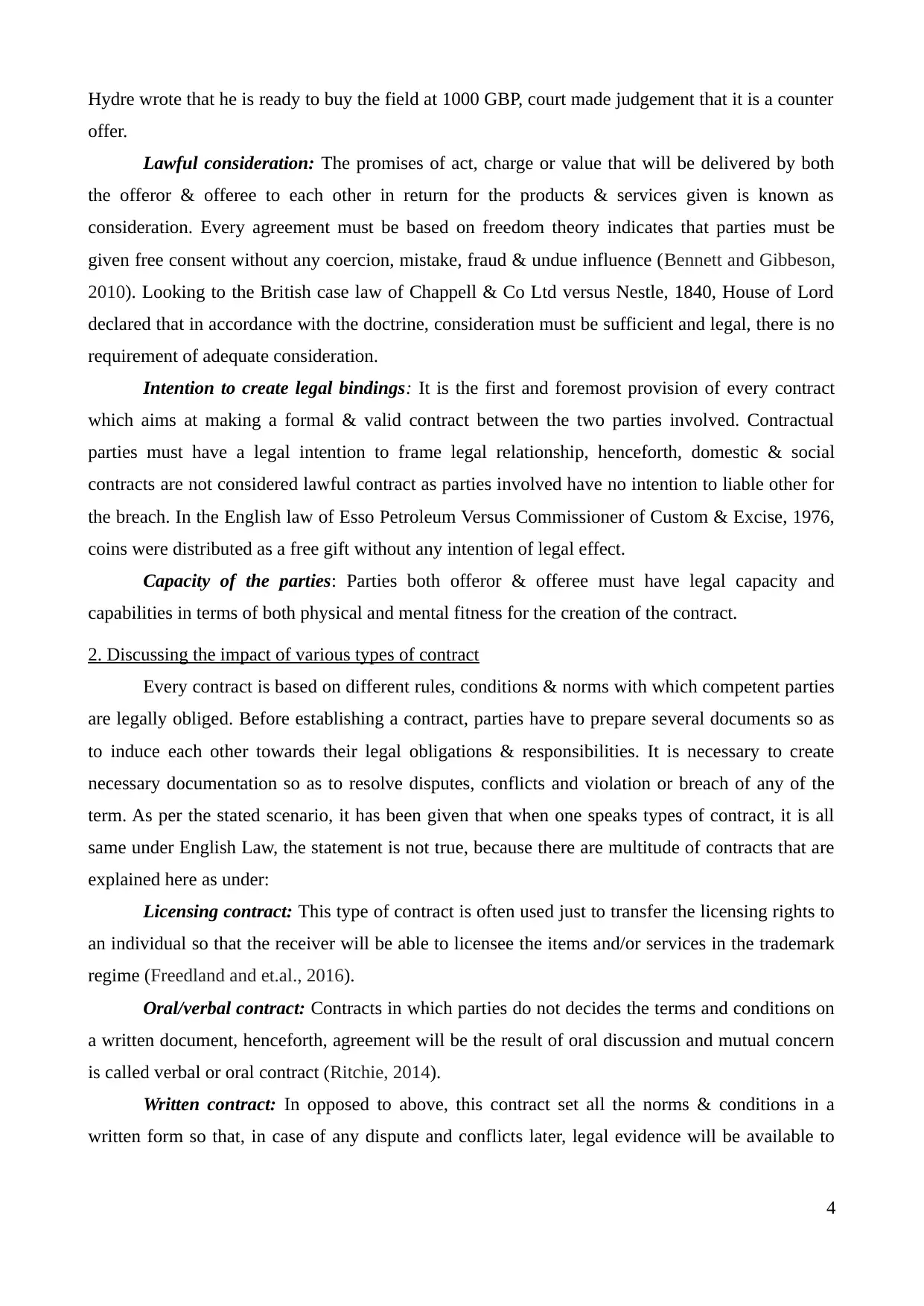
Hydre wrote that he is ready to buy the field at 1000 GBP, court made judgement that it is a counter
offer.
Lawful consideration: The promises of act, charge or value that will be delivered by both
the offeror & offeree to each other in return for the products & services given is known as
consideration. Every agreement must be based on freedom theory indicates that parties must be
given free consent without any coercion, mistake, fraud & undue influence (Bennett and Gibbeson,
2010). Looking to the British case law of Chappell & Co Ltd versus Nestle, 1840, House of Lord
declared that in accordance with the doctrine, consideration must be sufficient and legal, there is no
requirement of adequate consideration.
Intention to create legal bindings: It is the first and foremost provision of every contract
which aims at making a formal & valid contract between the two parties involved. Contractual
parties must have a legal intention to frame legal relationship, henceforth, domestic & social
contracts are not considered lawful contract as parties involved have no intention to liable other for
the breach. In the English law of Esso Petroleum Versus Commissioner of Custom & Excise, 1976,
coins were distributed as a free gift without any intention of legal effect.
Capacity of the parties: Parties both offeror & offeree must have legal capacity and
capabilities in terms of both physical and mental fitness for the creation of the contract.
2. Discussing the impact of various types of contract
Every contract is based on different rules, conditions & norms with which competent parties
are legally obliged. Before establishing a contract, parties have to prepare several documents so as
to induce each other towards their legal obligations & responsibilities. It is necessary to create
necessary documentation so as to resolve disputes, conflicts and violation or breach of any of the
term. As per the stated scenario, it has been given that when one speaks types of contract, it is all
same under English Law, the statement is not true, because there are multitude of contracts that are
explained here as under:
Licensing contract: This type of contract is often used just to transfer the licensing rights to
an individual so that the receiver will be able to licensee the items and/or services in the trademark
regime (Freedland and et.al., 2016).
Oral/verbal contract: Contracts in which parties do not decides the terms and conditions on
a written document, henceforth, agreement will be the result of oral discussion and mutual concern
is called verbal or oral contract (Ritchie, 2014).
Written contract: In opposed to above, this contract set all the norms & conditions in a
written form so that, in case of any dispute and conflicts later, legal evidence will be available to
4
offer.
Lawful consideration: The promises of act, charge or value that will be delivered by both
the offeror & offeree to each other in return for the products & services given is known as
consideration. Every agreement must be based on freedom theory indicates that parties must be
given free consent without any coercion, mistake, fraud & undue influence (Bennett and Gibbeson,
2010). Looking to the British case law of Chappell & Co Ltd versus Nestle, 1840, House of Lord
declared that in accordance with the doctrine, consideration must be sufficient and legal, there is no
requirement of adequate consideration.
Intention to create legal bindings: It is the first and foremost provision of every contract
which aims at making a formal & valid contract between the two parties involved. Contractual
parties must have a legal intention to frame legal relationship, henceforth, domestic & social
contracts are not considered lawful contract as parties involved have no intention to liable other for
the breach. In the English law of Esso Petroleum Versus Commissioner of Custom & Excise, 1976,
coins were distributed as a free gift without any intention of legal effect.
Capacity of the parties: Parties both offeror & offeree must have legal capacity and
capabilities in terms of both physical and mental fitness for the creation of the contract.
2. Discussing the impact of various types of contract
Every contract is based on different rules, conditions & norms with which competent parties
are legally obliged. Before establishing a contract, parties have to prepare several documents so as
to induce each other towards their legal obligations & responsibilities. It is necessary to create
necessary documentation so as to resolve disputes, conflicts and violation or breach of any of the
term. As per the stated scenario, it has been given that when one speaks types of contract, it is all
same under English Law, the statement is not true, because there are multitude of contracts that are
explained here as under:
Licensing contract: This type of contract is often used just to transfer the licensing rights to
an individual so that the receiver will be able to licensee the items and/or services in the trademark
regime (Freedland and et.al., 2016).
Oral/verbal contract: Contracts in which parties do not decides the terms and conditions on
a written document, henceforth, agreement will be the result of oral discussion and mutual concern
is called verbal or oral contract (Ritchie, 2014).
Written contract: In opposed to above, this contract set all the norms & conditions in a
written form so that, in case of any dispute and conflicts later, legal evidence will be available to
4
Secure Best Marks with AI Grader
Need help grading? Try our AI Grader for instant feedback on your assignments.
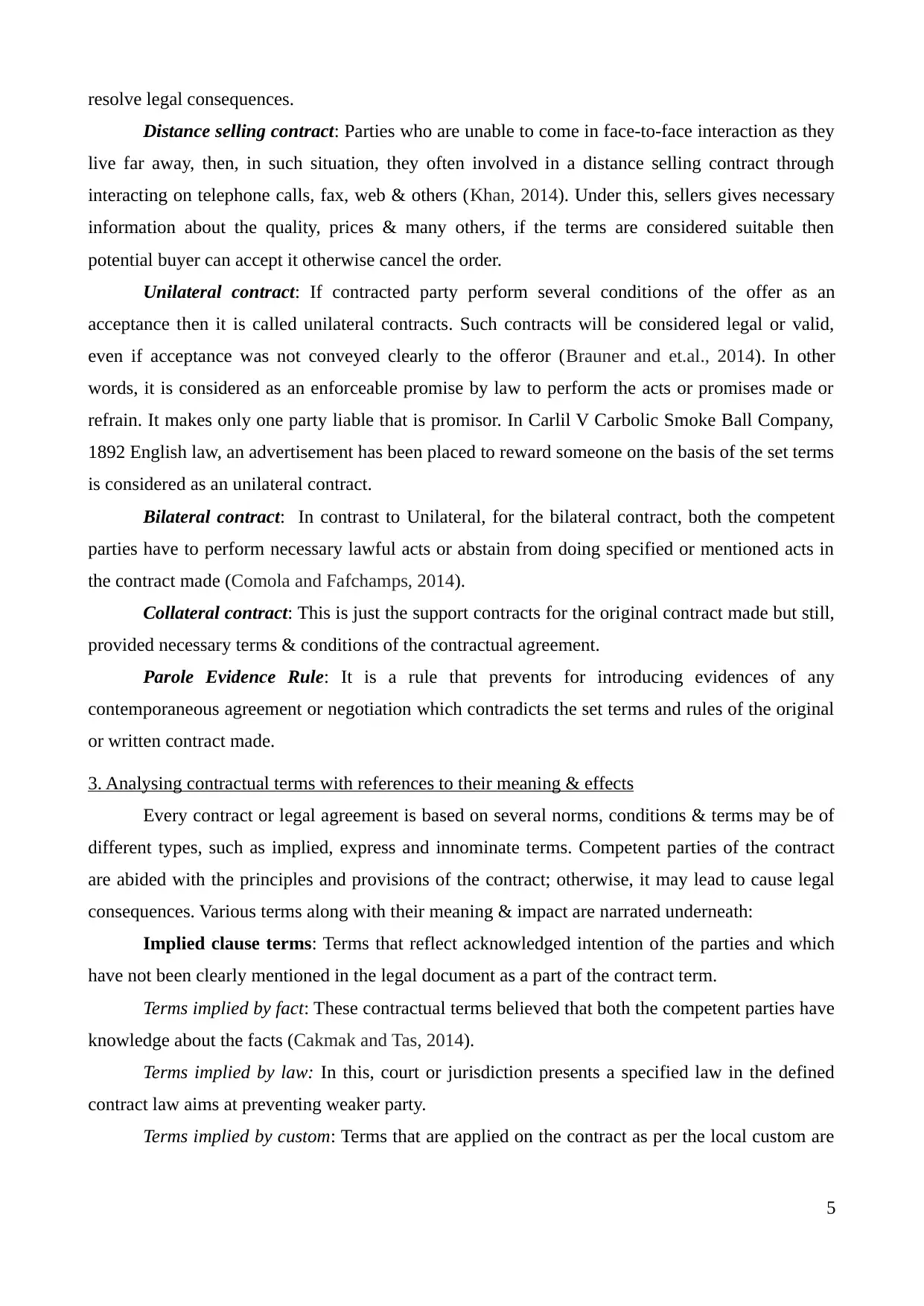
resolve legal consequences.
Distance selling contract: Parties who are unable to come in face-to-face interaction as they
live far away, then, in such situation, they often involved in a distance selling contract through
interacting on telephone calls, fax, web & others (Khan, 2014). Under this, sellers gives necessary
information about the quality, prices & many others, if the terms are considered suitable then
potential buyer can accept it otherwise cancel the order.
Unilateral contract: If contracted party perform several conditions of the offer as an
acceptance then it is called unilateral contracts. Such contracts will be considered legal or valid,
even if acceptance was not conveyed clearly to the offeror (Brauner and et.al., 2014). In other
words, it is considered as an enforceable promise by law to perform the acts or promises made or
refrain. It makes only one party liable that is promisor. In Carlil V Carbolic Smoke Ball Company,
1892 English law, an advertisement has been placed to reward someone on the basis of the set terms
is considered as an unilateral contract.
Bilateral contract: In contrast to Unilateral, for the bilateral contract, both the competent
parties have to perform necessary lawful acts or abstain from doing specified or mentioned acts in
the contract made (Comola and Fafchamps, 2014).
Collateral contract: This is just the support contracts for the original contract made but still,
provided necessary terms & conditions of the contractual agreement.
Parole Evidence Rule: It is a rule that prevents for introducing evidences of any
contemporaneous agreement or negotiation which contradicts the set terms and rules of the original
or written contract made.
3. Analysing contractual terms with references to their meaning & effects
Every contract or legal agreement is based on several norms, conditions & terms may be of
different types, such as implied, express and innominate terms. Competent parties of the contract
are abided with the principles and provisions of the contract; otherwise, it may lead to cause legal
consequences. Various terms along with their meaning & impact are narrated underneath:
Implied clause terms: Terms that reflect acknowledged intention of the parties and which
have not been clearly mentioned in the legal document as a part of the contract term.
Terms implied by fact: These contractual terms believed that both the competent parties have
knowledge about the facts (Cakmak and Tas, 2014).
Terms implied by law: In this, court or jurisdiction presents a specified law in the defined
contract law aims at preventing weaker party.
Terms implied by custom: Terms that are applied on the contract as per the local custom are
5
Distance selling contract: Parties who are unable to come in face-to-face interaction as they
live far away, then, in such situation, they often involved in a distance selling contract through
interacting on telephone calls, fax, web & others (Khan, 2014). Under this, sellers gives necessary
information about the quality, prices & many others, if the terms are considered suitable then
potential buyer can accept it otherwise cancel the order.
Unilateral contract: If contracted party perform several conditions of the offer as an
acceptance then it is called unilateral contracts. Such contracts will be considered legal or valid,
even if acceptance was not conveyed clearly to the offeror (Brauner and et.al., 2014). In other
words, it is considered as an enforceable promise by law to perform the acts or promises made or
refrain. It makes only one party liable that is promisor. In Carlil V Carbolic Smoke Ball Company,
1892 English law, an advertisement has been placed to reward someone on the basis of the set terms
is considered as an unilateral contract.
Bilateral contract: In contrast to Unilateral, for the bilateral contract, both the competent
parties have to perform necessary lawful acts or abstain from doing specified or mentioned acts in
the contract made (Comola and Fafchamps, 2014).
Collateral contract: This is just the support contracts for the original contract made but still,
provided necessary terms & conditions of the contractual agreement.
Parole Evidence Rule: It is a rule that prevents for introducing evidences of any
contemporaneous agreement or negotiation which contradicts the set terms and rules of the original
or written contract made.
3. Analysing contractual terms with references to their meaning & effects
Every contract or legal agreement is based on several norms, conditions & terms may be of
different types, such as implied, express and innominate terms. Competent parties of the contract
are abided with the principles and provisions of the contract; otherwise, it may lead to cause legal
consequences. Various terms along with their meaning & impact are narrated underneath:
Implied clause terms: Terms that reflect acknowledged intention of the parties and which
have not been clearly mentioned in the legal document as a part of the contract term.
Terms implied by fact: These contractual terms believed that both the competent parties have
knowledge about the facts (Cakmak and Tas, 2014).
Terms implied by law: In this, court or jurisdiction presents a specified law in the defined
contract law aims at preventing weaker party.
Terms implied by custom: Terms that are applied on the contract as per the local custom are
5
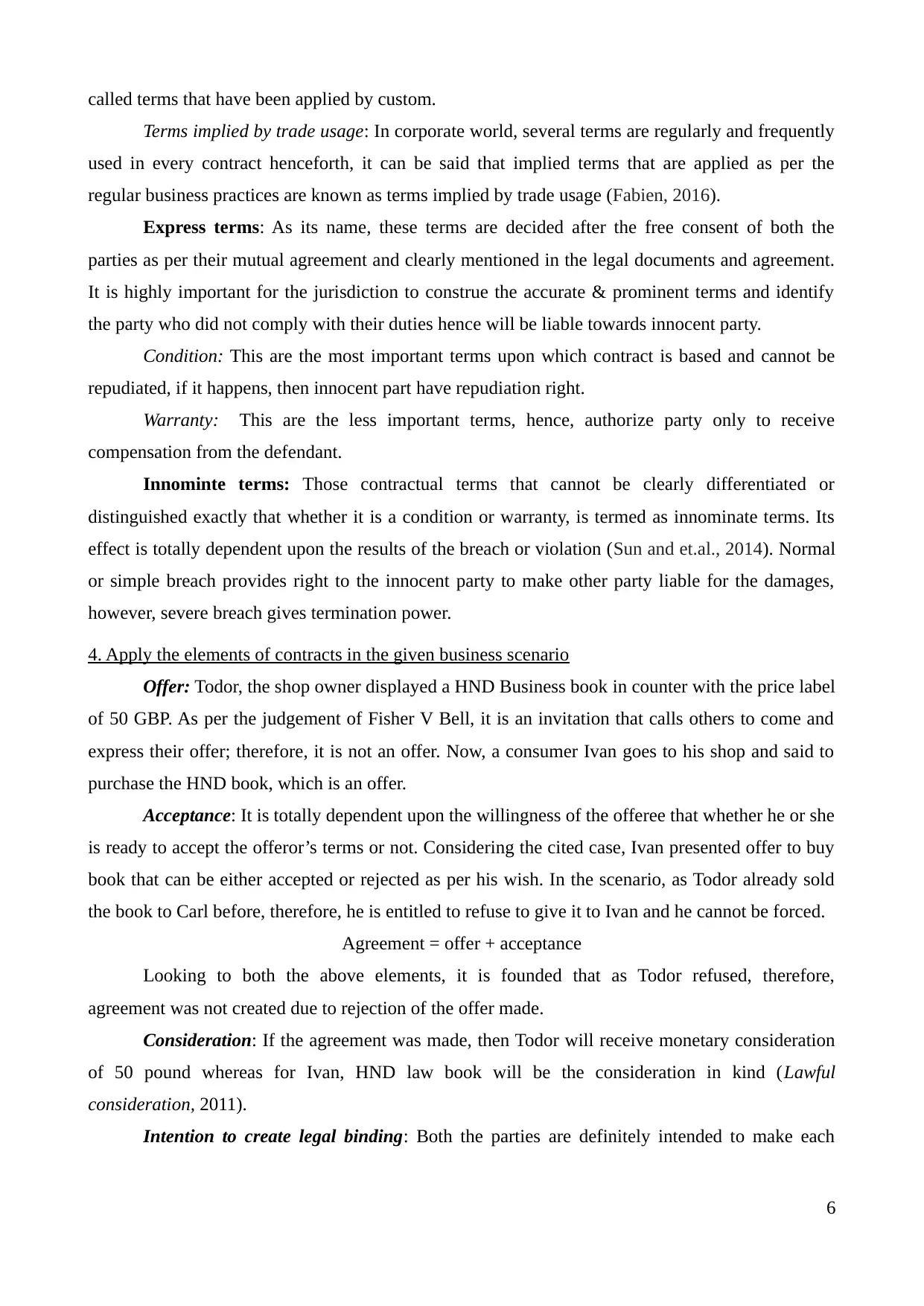
called terms that have been applied by custom.
Terms implied by trade usage: In corporate world, several terms are regularly and frequently
used in every contract henceforth, it can be said that implied terms that are applied as per the
regular business practices are known as terms implied by trade usage (Fabien, 2016).
Express terms: As its name, these terms are decided after the free consent of both the
parties as per their mutual agreement and clearly mentioned in the legal documents and agreement.
It is highly important for the jurisdiction to construe the accurate & prominent terms and identify
the party who did not comply with their duties hence will be liable towards innocent party.
Condition: This are the most important terms upon which contract is based and cannot be
repudiated, if it happens, then innocent part have repudiation right.
Warranty: This are the less important terms, hence, authorize party only to receive
compensation from the defendant.
Innominte terms: Those contractual terms that cannot be clearly differentiated or
distinguished exactly that whether it is a condition or warranty, is termed as innominate terms. Its
effect is totally dependent upon the results of the breach or violation (Sun and et.al., 2014). Normal
or simple breach provides right to the innocent party to make other party liable for the damages,
however, severe breach gives termination power.
4. Apply the elements of contracts in the given business scenario
Offer: Todor, the shop owner displayed a HND Business book in counter with the price label
of 50 GBP. As per the judgement of Fisher V Bell, it is an invitation that calls others to come and
express their offer; therefore, it is not an offer. Now, a consumer Ivan goes to his shop and said to
purchase the HND book, which is an offer.
Acceptance: It is totally dependent upon the willingness of the offeree that whether he or she
is ready to accept the offeror’s terms or not. Considering the cited case, Ivan presented offer to buy
book that can be either accepted or rejected as per his wish. In the scenario, as Todor already sold
the book to Carl before, therefore, he is entitled to refuse to give it to Ivan and he cannot be forced.
Agreement = offer + acceptance
Looking to both the above elements, it is founded that as Todor refused, therefore,
agreement was not created due to rejection of the offer made.
Consideration: If the agreement was made, then Todor will receive monetary consideration
of 50 pound whereas for Ivan, HND law book will be the consideration in kind (Lawful
consideration, 2011).
Intention to create legal binding: Both the parties are definitely intended to make each
6
Terms implied by trade usage: In corporate world, several terms are regularly and frequently
used in every contract henceforth, it can be said that implied terms that are applied as per the
regular business practices are known as terms implied by trade usage (Fabien, 2016).
Express terms: As its name, these terms are decided after the free consent of both the
parties as per their mutual agreement and clearly mentioned in the legal documents and agreement.
It is highly important for the jurisdiction to construe the accurate & prominent terms and identify
the party who did not comply with their duties hence will be liable towards innocent party.
Condition: This are the most important terms upon which contract is based and cannot be
repudiated, if it happens, then innocent part have repudiation right.
Warranty: This are the less important terms, hence, authorize party only to receive
compensation from the defendant.
Innominte terms: Those contractual terms that cannot be clearly differentiated or
distinguished exactly that whether it is a condition or warranty, is termed as innominate terms. Its
effect is totally dependent upon the results of the breach or violation (Sun and et.al., 2014). Normal
or simple breach provides right to the innocent party to make other party liable for the damages,
however, severe breach gives termination power.
4. Apply the elements of contracts in the given business scenario
Offer: Todor, the shop owner displayed a HND Business book in counter with the price label
of 50 GBP. As per the judgement of Fisher V Bell, it is an invitation that calls others to come and
express their offer; therefore, it is not an offer. Now, a consumer Ivan goes to his shop and said to
purchase the HND book, which is an offer.
Acceptance: It is totally dependent upon the willingness of the offeree that whether he or she
is ready to accept the offeror’s terms or not. Considering the cited case, Ivan presented offer to buy
book that can be either accepted or rejected as per his wish. In the scenario, as Todor already sold
the book to Carl before, therefore, he is entitled to refuse to give it to Ivan and he cannot be forced.
Agreement = offer + acceptance
Looking to both the above elements, it is founded that as Todor refused, therefore,
agreement was not created due to rejection of the offer made.
Consideration: If the agreement was made, then Todor will receive monetary consideration
of 50 pound whereas for Ivan, HND law book will be the consideration in kind (Lawful
consideration, 2011).
Intention to create legal binding: Both the parties are definitely intended to make each
6
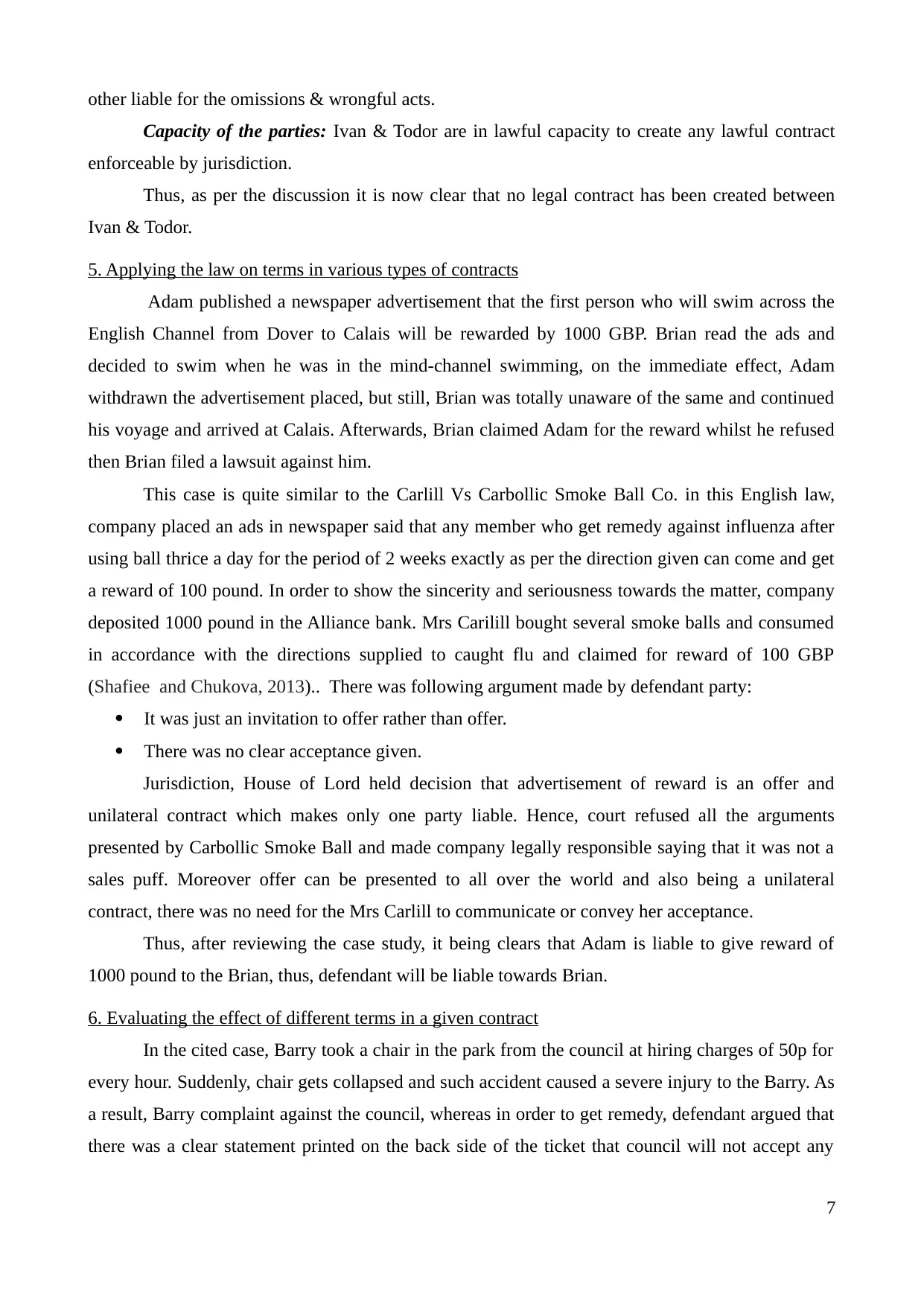
other liable for the omissions & wrongful acts.
Capacity of the parties: Ivan & Todor are in lawful capacity to create any lawful contract
enforceable by jurisdiction.
Thus, as per the discussion it is now clear that no legal contract has been created between
Ivan & Todor.
5. Applying the law on terms in various types of contracts
Adam published a newspaper advertisement that the first person who will swim across the
English Channel from Dover to Calais will be rewarded by 1000 GBP. Brian read the ads and
decided to swim when he was in the mind-channel swimming, on the immediate effect, Adam
withdrawn the advertisement placed, but still, Brian was totally unaware of the same and continued
his voyage and arrived at Calais. Afterwards, Brian claimed Adam for the reward whilst he refused
then Brian filed a lawsuit against him.
This case is quite similar to the Carlill Vs Carbollic Smoke Ball Co. in this English law,
company placed an ads in newspaper said that any member who get remedy against influenza after
using ball thrice a day for the period of 2 weeks exactly as per the direction given can come and get
a reward of 100 pound. In order to show the sincerity and seriousness towards the matter, company
deposited 1000 pound in the Alliance bank. Mrs Carilill bought several smoke balls and consumed
in accordance with the directions supplied to caught flu and claimed for reward of 100 GBP
(Shafiee and Chukova, 2013).. There was following argument made by defendant party:
It was just an invitation to offer rather than offer.
There was no clear acceptance given.
Jurisdiction, House of Lord held decision that advertisement of reward is an offer and
unilateral contract which makes only one party liable. Hence, court refused all the arguments
presented by Carbollic Smoke Ball and made company legally responsible saying that it was not a
sales puff. Moreover offer can be presented to all over the world and also being a unilateral
contract, there was no need for the Mrs Carlill to communicate or convey her acceptance.
Thus, after reviewing the case study, it being clears that Adam is liable to give reward of
1000 pound to the Brian, thus, defendant will be liable towards Brian.
6. Evaluating the effect of different terms in a given contract
In the cited case, Barry took a chair in the park from the council at hiring charges of 50p for
every hour. Suddenly, chair gets collapsed and such accident caused a severe injury to the Barry. As
a result, Barry complaint against the council, whereas in order to get remedy, defendant argued that
there was a clear statement printed on the back side of the ticket that council will not accept any
7
Capacity of the parties: Ivan & Todor are in lawful capacity to create any lawful contract
enforceable by jurisdiction.
Thus, as per the discussion it is now clear that no legal contract has been created between
Ivan & Todor.
5. Applying the law on terms in various types of contracts
Adam published a newspaper advertisement that the first person who will swim across the
English Channel from Dover to Calais will be rewarded by 1000 GBP. Brian read the ads and
decided to swim when he was in the mind-channel swimming, on the immediate effect, Adam
withdrawn the advertisement placed, but still, Brian was totally unaware of the same and continued
his voyage and arrived at Calais. Afterwards, Brian claimed Adam for the reward whilst he refused
then Brian filed a lawsuit against him.
This case is quite similar to the Carlill Vs Carbollic Smoke Ball Co. in this English law,
company placed an ads in newspaper said that any member who get remedy against influenza after
using ball thrice a day for the period of 2 weeks exactly as per the direction given can come and get
a reward of 100 pound. In order to show the sincerity and seriousness towards the matter, company
deposited 1000 pound in the Alliance bank. Mrs Carilill bought several smoke balls and consumed
in accordance with the directions supplied to caught flu and claimed for reward of 100 GBP
(Shafiee and Chukova, 2013).. There was following argument made by defendant party:
It was just an invitation to offer rather than offer.
There was no clear acceptance given.
Jurisdiction, House of Lord held decision that advertisement of reward is an offer and
unilateral contract which makes only one party liable. Hence, court refused all the arguments
presented by Carbollic Smoke Ball and made company legally responsible saying that it was not a
sales puff. Moreover offer can be presented to all over the world and also being a unilateral
contract, there was no need for the Mrs Carlill to communicate or convey her acceptance.
Thus, after reviewing the case study, it being clears that Adam is liable to give reward of
1000 pound to the Brian, thus, defendant will be liable towards Brian.
6. Evaluating the effect of different terms in a given contract
In the cited case, Barry took a chair in the park from the council at hiring charges of 50p for
every hour. Suddenly, chair gets collapsed and such accident caused a severe injury to the Barry. As
a result, Barry complaint against the council, whereas in order to get remedy, defendant argued that
there was a clear statement printed on the back side of the ticket that council will not accept any
7
Paraphrase This Document
Need a fresh take? Get an instant paraphrase of this document with our AI Paraphraser
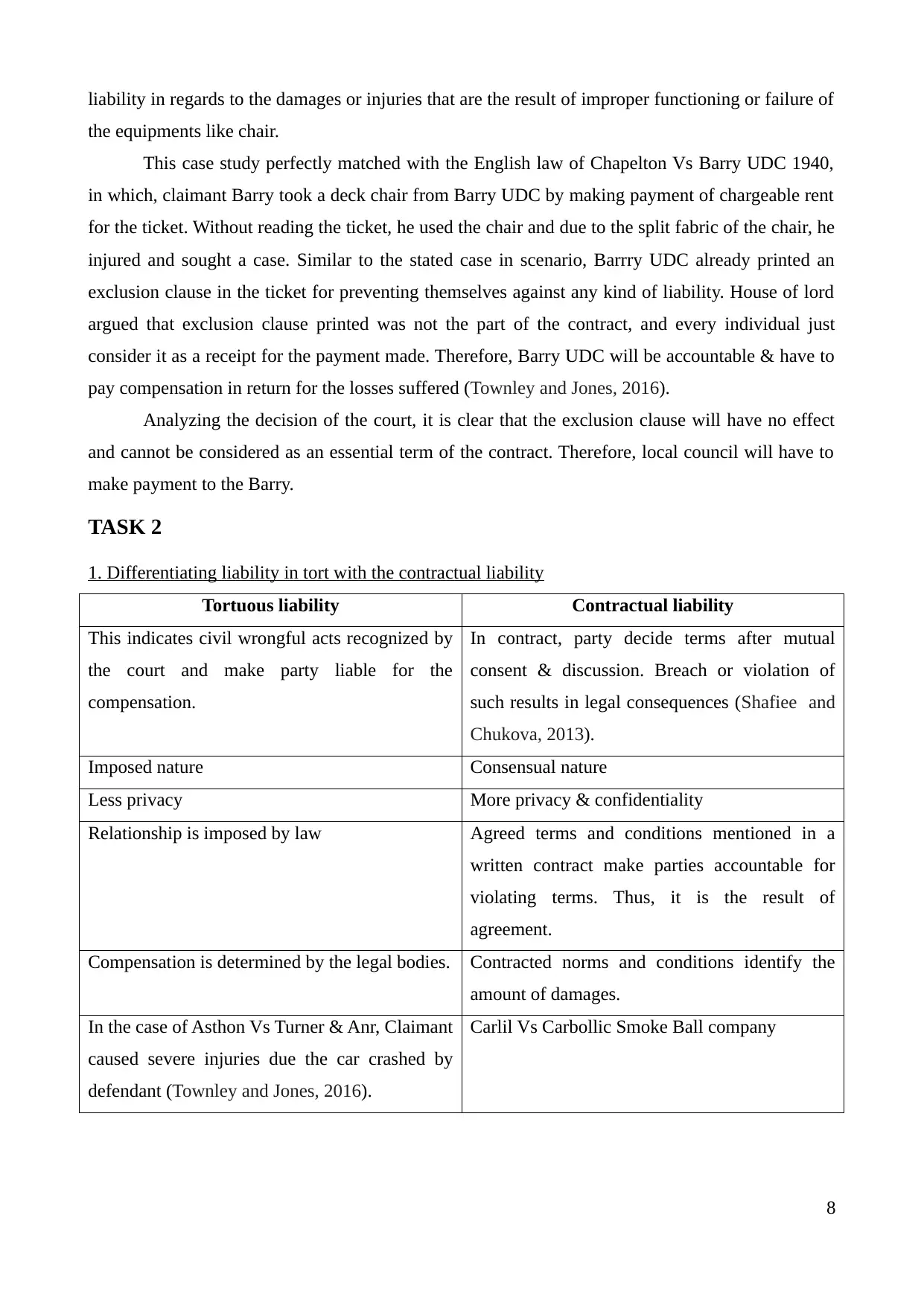
liability in regards to the damages or injuries that are the result of improper functioning or failure of
the equipments like chair.
This case study perfectly matched with the English law of Chapelton Vs Barry UDC 1940,
in which, claimant Barry took a deck chair from Barry UDC by making payment of chargeable rent
for the ticket. Without reading the ticket, he used the chair and due to the split fabric of the chair, he
injured and sought a case. Similar to the stated case in scenario, Barrry UDC already printed an
exclusion clause in the ticket for preventing themselves against any kind of liability. House of lord
argued that exclusion clause printed was not the part of the contract, and every individual just
consider it as a receipt for the payment made. Therefore, Barry UDC will be accountable & have to
pay compensation in return for the losses suffered (Townley and Jones, 2016).
Analyzing the decision of the court, it is clear that the exclusion clause will have no effect
and cannot be considered as an essential term of the contract. Therefore, local council will have to
make payment to the Barry.
TASK 2
1. Differentiating liability in tort with the contractual liability
Tortuous liability Contractual liability
This indicates civil wrongful acts recognized by
the court and make party liable for the
compensation.
In contract, party decide terms after mutual
consent & discussion. Breach or violation of
such results in legal consequences (Shafiee and
Chukova, 2013).
Imposed nature Consensual nature
Less privacy More privacy & confidentiality
Relationship is imposed by law Agreed terms and conditions mentioned in a
written contract make parties accountable for
violating terms. Thus, it is the result of
agreement.
Compensation is determined by the legal bodies. Contracted norms and conditions identify the
amount of damages.
In the case of Asthon Vs Turner & Anr, Claimant
caused severe injuries due the car crashed by
defendant (Townley and Jones, 2016).
Carlil Vs Carbollic Smoke Ball company
8
the equipments like chair.
This case study perfectly matched with the English law of Chapelton Vs Barry UDC 1940,
in which, claimant Barry took a deck chair from Barry UDC by making payment of chargeable rent
for the ticket. Without reading the ticket, he used the chair and due to the split fabric of the chair, he
injured and sought a case. Similar to the stated case in scenario, Barrry UDC already printed an
exclusion clause in the ticket for preventing themselves against any kind of liability. House of lord
argued that exclusion clause printed was not the part of the contract, and every individual just
consider it as a receipt for the payment made. Therefore, Barry UDC will be accountable & have to
pay compensation in return for the losses suffered (Townley and Jones, 2016).
Analyzing the decision of the court, it is clear that the exclusion clause will have no effect
and cannot be considered as an essential term of the contract. Therefore, local council will have to
make payment to the Barry.
TASK 2
1. Differentiating liability in tort with the contractual liability
Tortuous liability Contractual liability
This indicates civil wrongful acts recognized by
the court and make party liable for the
compensation.
In contract, party decide terms after mutual
consent & discussion. Breach or violation of
such results in legal consequences (Shafiee and
Chukova, 2013).
Imposed nature Consensual nature
Less privacy More privacy & confidentiality
Relationship is imposed by law Agreed terms and conditions mentioned in a
written contract make parties accountable for
violating terms. Thus, it is the result of
agreement.
Compensation is determined by the legal bodies. Contracted norms and conditions identify the
amount of damages.
In the case of Asthon Vs Turner & Anr, Claimant
caused severe injuries due the car crashed by
defendant (Townley and Jones, 2016).
Carlil Vs Carbollic Smoke Ball company
8

2. Explaining the nature of liability in negligence
Negligence is the failure of owed responsibilities towards other party due to careless
attitude. Although, it is just accidental not the intentional and demonstrates that defaulters was well
known that probable risk can be caused to the party if he or she fails to comply with certain
principles (Schwartz and Rowe, 2010). Present scenario states that Ben is the Owner of Regent
Hotel situated in Wembley to whom Roger, the dishwasher of the hotel had compliant about the
rashes on his skin resulted due to the long washing period. Although rubber gloves were provided to
him, still he did not used them while washing utensils. Now, the question is that is Ben is liable
towards negligence’s against Roger for non-compliance with the safety working environment rules.
It can be answered after applying the provisions & necessary elements of negligence principles,
stated below:
Duty of care is the prior most important facet of making a person negligibly liable towards
claimant. Referring the case, being an employer, Ben owed the duty of care and abided with
the safety and health at workplace law (O'Sullivan, 2016).
Breach of duty is the second requirement, however, in the case, there was no duty violated
because Ben already followed safety measures and provided rubber gloves to the Roger,
therefore, duty of care has been fully complied.
Loss must be the reasons of failure of adhering with the careless principles. In this case,
hotel owner fulfilled its responsibility, whereas, Roger was self-responsible for the skin
rushing issues as he did not worn gloves.
In Nettleship Vs Weston, 1971, court argued that it was expected from the learner
driver to follow the similar standards as a reasonable or experienced driver, while he failed
and unable to waive any compensation rights. Referring the case study, defence of volenti is
available to Ben arguing the Roger’s claim that his own actions to not wear gloves was the
reason for the skin rashes, therefore, hotel owner owes no liability to compensate. Apart
from this, contributory negligence, volenti non-fit injuria, Ex-turpi causa & exclusion
liabilities are several defences available to defendant to get remedy against negligence.
3. Explaining how a business can be vicariously liable
In English doctrine, vicarious liability has been applied to held employer rigorously
accountable for any wrongdoing of their any staff member. Under such cirumustances, although
employer cannot be blamed, still, liability will be caused due to the undesired or misconduct of their
workers (Giliker, 2010).
In the given case scenario B, it has been stated that head chef of the hotel, Colin became
9
Negligence is the failure of owed responsibilities towards other party due to careless
attitude. Although, it is just accidental not the intentional and demonstrates that defaulters was well
known that probable risk can be caused to the party if he or she fails to comply with certain
principles (Schwartz and Rowe, 2010). Present scenario states that Ben is the Owner of Regent
Hotel situated in Wembley to whom Roger, the dishwasher of the hotel had compliant about the
rashes on his skin resulted due to the long washing period. Although rubber gloves were provided to
him, still he did not used them while washing utensils. Now, the question is that is Ben is liable
towards negligence’s against Roger for non-compliance with the safety working environment rules.
It can be answered after applying the provisions & necessary elements of negligence principles,
stated below:
Duty of care is the prior most important facet of making a person negligibly liable towards
claimant. Referring the case, being an employer, Ben owed the duty of care and abided with
the safety and health at workplace law (O'Sullivan, 2016).
Breach of duty is the second requirement, however, in the case, there was no duty violated
because Ben already followed safety measures and provided rubber gloves to the Roger,
therefore, duty of care has been fully complied.
Loss must be the reasons of failure of adhering with the careless principles. In this case,
hotel owner fulfilled its responsibility, whereas, Roger was self-responsible for the skin
rushing issues as he did not worn gloves.
In Nettleship Vs Weston, 1971, court argued that it was expected from the learner
driver to follow the similar standards as a reasonable or experienced driver, while he failed
and unable to waive any compensation rights. Referring the case study, defence of volenti is
available to Ben arguing the Roger’s claim that his own actions to not wear gloves was the
reason for the skin rashes, therefore, hotel owner owes no liability to compensate. Apart
from this, contributory negligence, volenti non-fit injuria, Ex-turpi causa & exclusion
liabilities are several defences available to defendant to get remedy against negligence.
3. Explaining how a business can be vicariously liable
In English doctrine, vicarious liability has been applied to held employer rigorously
accountable for any wrongdoing of their any staff member. Under such cirumustances, although
employer cannot be blamed, still, liability will be caused due to the undesired or misconduct of their
workers (Giliker, 2010).
In the given case scenario B, it has been stated that head chef of the hotel, Colin became
9
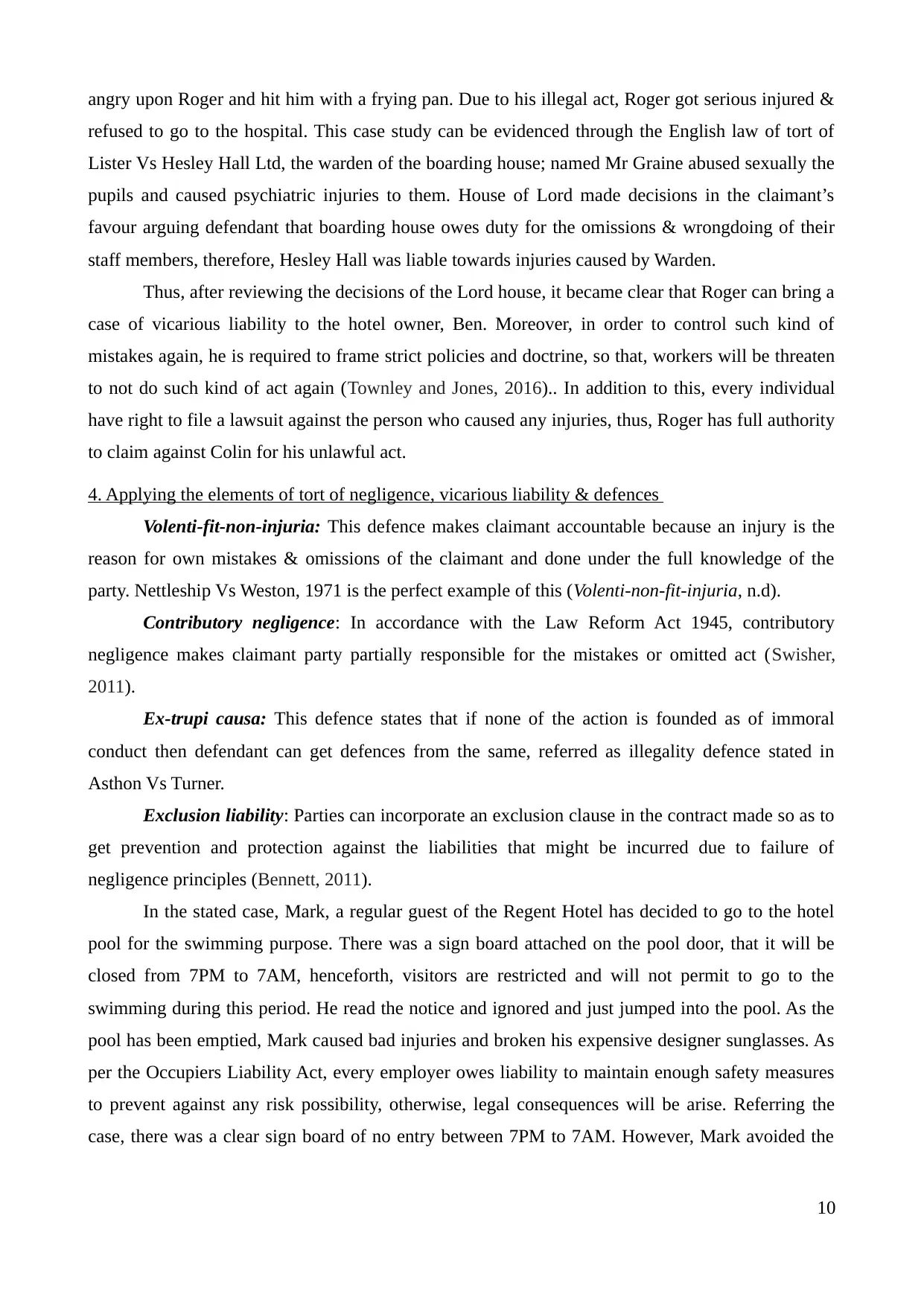
angry upon Roger and hit him with a frying pan. Due to his illegal act, Roger got serious injured &
refused to go to the hospital. This case study can be evidenced through the English law of tort of
Lister Vs Hesley Hall Ltd, the warden of the boarding house; named Mr Graine abused sexually the
pupils and caused psychiatric injuries to them. House of Lord made decisions in the claimant’s
favour arguing defendant that boarding house owes duty for the omissions & wrongdoing of their
staff members, therefore, Hesley Hall was liable towards injuries caused by Warden.
Thus, after reviewing the decisions of the Lord house, it became clear that Roger can bring a
case of vicarious liability to the hotel owner, Ben. Moreover, in order to control such kind of
mistakes again, he is required to frame strict policies and doctrine, so that, workers will be threaten
to not do such kind of act again (Townley and Jones, 2016).. In addition to this, every individual
have right to file a lawsuit against the person who caused any injuries, thus, Roger has full authority
to claim against Colin for his unlawful act.
4. Applying the elements of tort of negligence, vicarious liability & defences
Volenti-fit-non-injuria: This defence makes claimant accountable because an injury is the
reason for own mistakes & omissions of the claimant and done under the full knowledge of the
party. Nettleship Vs Weston, 1971 is the perfect example of this (Volenti-non-fit-injuria, n.d).
Contributory negligence: In accordance with the Law Reform Act 1945, contributory
negligence makes claimant party partially responsible for the mistakes or omitted act (Swisher,
2011).
Ex-trupi causa: This defence states that if none of the action is founded as of immoral
conduct then defendant can get defences from the same, referred as illegality defence stated in
Asthon Vs Turner.
Exclusion liability: Parties can incorporate an exclusion clause in the contract made so as to
get prevention and protection against the liabilities that might be incurred due to failure of
negligence principles (Bennett, 2011).
In the stated case, Mark, a regular guest of the Regent Hotel has decided to go to the hotel
pool for the swimming purpose. There was a sign board attached on the pool door, that it will be
closed from 7PM to 7AM, henceforth, visitors are restricted and will not permit to go to the
swimming during this period. He read the notice and ignored and just jumped into the pool. As the
pool has been emptied, Mark caused bad injuries and broken his expensive designer sunglasses. As
per the Occupiers Liability Act, every employer owes liability to maintain enough safety measures
to prevent against any risk possibility, otherwise, legal consequences will be arise. Referring the
case, there was a clear sign board of no entry between 7PM to 7AM. However, Mark avoided the
10
refused to go to the hospital. This case study can be evidenced through the English law of tort of
Lister Vs Hesley Hall Ltd, the warden of the boarding house; named Mr Graine abused sexually the
pupils and caused psychiatric injuries to them. House of Lord made decisions in the claimant’s
favour arguing defendant that boarding house owes duty for the omissions & wrongdoing of their
staff members, therefore, Hesley Hall was liable towards injuries caused by Warden.
Thus, after reviewing the decisions of the Lord house, it became clear that Roger can bring a
case of vicarious liability to the hotel owner, Ben. Moreover, in order to control such kind of
mistakes again, he is required to frame strict policies and doctrine, so that, workers will be threaten
to not do such kind of act again (Townley and Jones, 2016).. In addition to this, every individual
have right to file a lawsuit against the person who caused any injuries, thus, Roger has full authority
to claim against Colin for his unlawful act.
4. Applying the elements of tort of negligence, vicarious liability & defences
Volenti-fit-non-injuria: This defence makes claimant accountable because an injury is the
reason for own mistakes & omissions of the claimant and done under the full knowledge of the
party. Nettleship Vs Weston, 1971 is the perfect example of this (Volenti-non-fit-injuria, n.d).
Contributory negligence: In accordance with the Law Reform Act 1945, contributory
negligence makes claimant party partially responsible for the mistakes or omitted act (Swisher,
2011).
Ex-trupi causa: This defence states that if none of the action is founded as of immoral
conduct then defendant can get defences from the same, referred as illegality defence stated in
Asthon Vs Turner.
Exclusion liability: Parties can incorporate an exclusion clause in the contract made so as to
get prevention and protection against the liabilities that might be incurred due to failure of
negligence principles (Bennett, 2011).
In the stated case, Mark, a regular guest of the Regent Hotel has decided to go to the hotel
pool for the swimming purpose. There was a sign board attached on the pool door, that it will be
closed from 7PM to 7AM, henceforth, visitors are restricted and will not permit to go to the
swimming during this period. He read the notice and ignored and just jumped into the pool. As the
pool has been emptied, Mark caused bad injuries and broken his expensive designer sunglasses. As
per the Occupiers Liability Act, every employer owes liability to maintain enough safety measures
to prevent against any risk possibility, otherwise, legal consequences will be arise. Referring the
case, there was a clear sign board of no entry between 7PM to 7AM. However, Mark avoided the
10
Secure Best Marks with AI Grader
Need help grading? Try our AI Grader for instant feedback on your assignments.
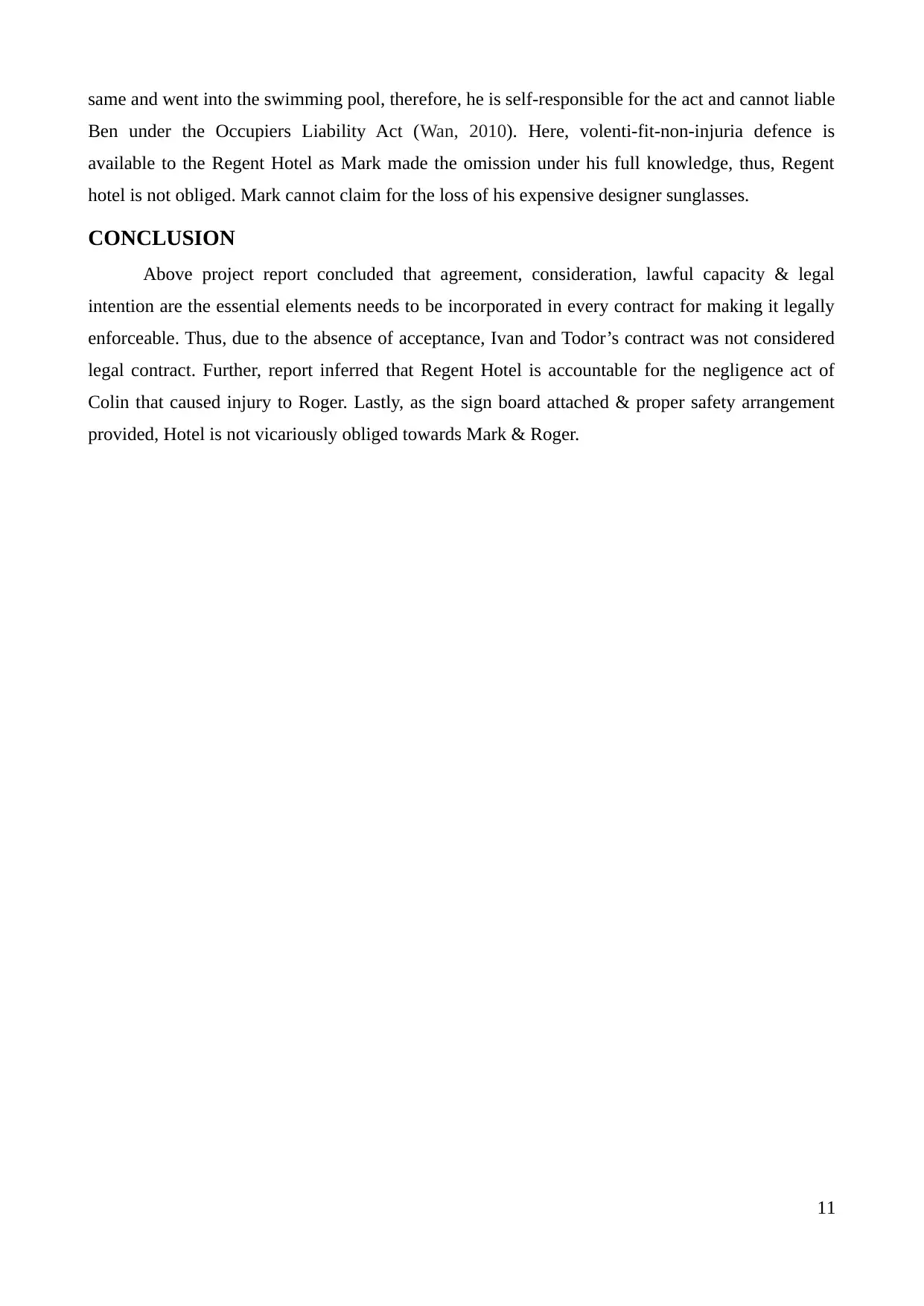
same and went into the swimming pool, therefore, he is self-responsible for the act and cannot liable
Ben under the Occupiers Liability Act (Wan, 2010). Here, volenti-fit-non-injuria defence is
available to the Regent Hotel as Mark made the omission under his full knowledge, thus, Regent
hotel is not obliged. Mark cannot claim for the loss of his expensive designer sunglasses.
CONCLUSION
Above project report concluded that agreement, consideration, lawful capacity & legal
intention are the essential elements needs to be incorporated in every contract for making it legally
enforceable. Thus, due to the absence of acceptance, Ivan and Todor’s contract was not considered
legal contract. Further, report inferred that Regent Hotel is accountable for the negligence act of
Colin that caused injury to Roger. Lastly, as the sign board attached & proper safety arrangement
provided, Hotel is not vicariously obliged towards Mark & Roger.
11
Ben under the Occupiers Liability Act (Wan, 2010). Here, volenti-fit-non-injuria defence is
available to the Regent Hotel as Mark made the omission under his full knowledge, thus, Regent
hotel is not obliged. Mark cannot claim for the loss of his expensive designer sunglasses.
CONCLUSION
Above project report concluded that agreement, consideration, lawful capacity & legal
intention are the essential elements needs to be incorporated in every contract for making it legally
enforceable. Thus, due to the absence of acceptance, Ivan and Todor’s contract was not considered
legal contract. Further, report inferred that Regent Hotel is accountable for the negligence act of
Colin that caused injury to Roger. Lastly, as the sign board attached & proper safety arrangement
provided, Hotel is not vicariously obliged towards Mark & Roger.
11
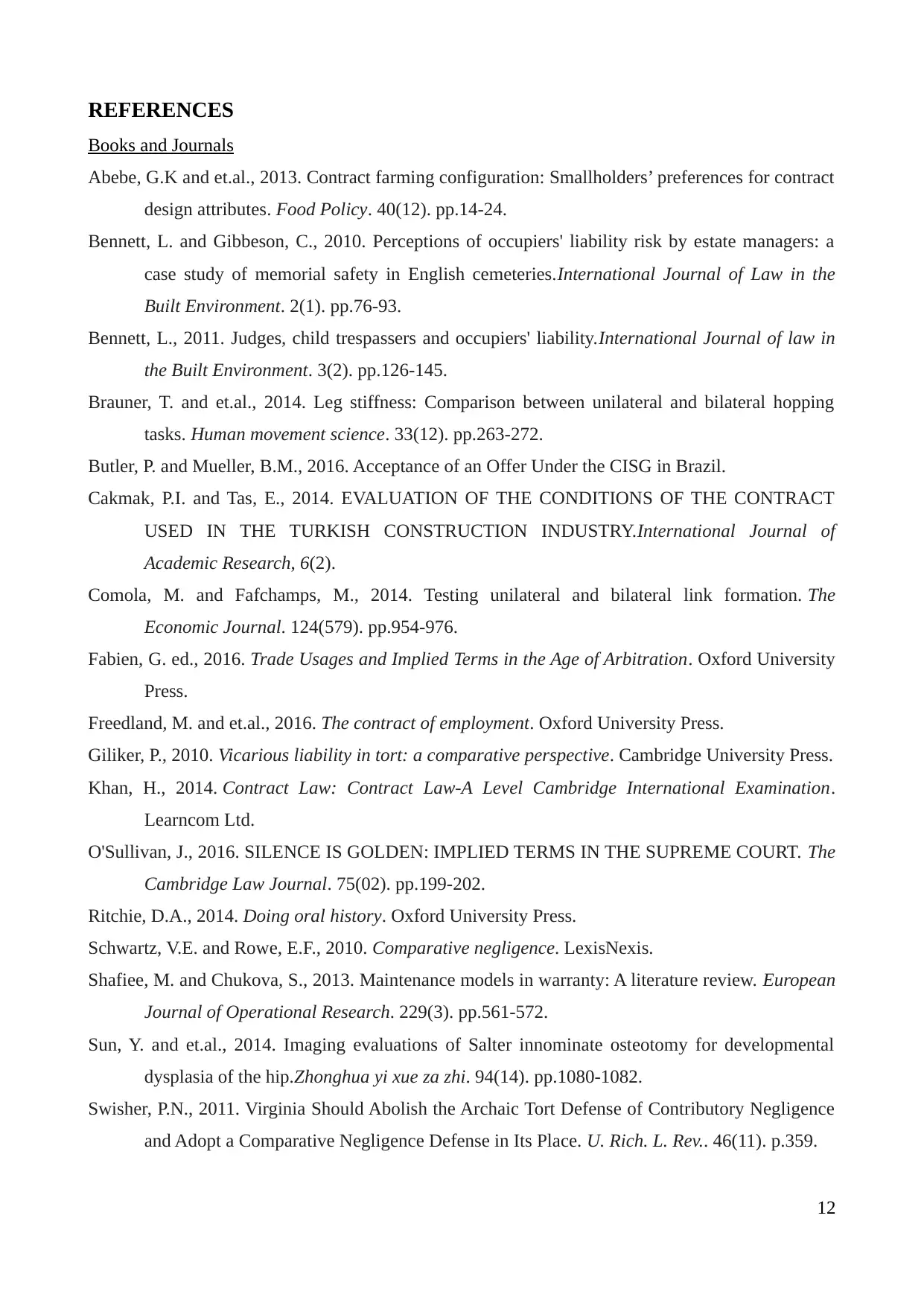
REFERENCES
Books and Journals
Abebe, G.K and et.al., 2013. Contract farming configuration: Smallholders’ preferences for contract
design attributes. Food Policy. 40(12). pp.14-24.
Bennett, L. and Gibbeson, C., 2010. Perceptions of occupiers' liability risk by estate managers: a
case study of memorial safety in English cemeteries.International Journal of Law in the
Built Environment. 2(1). pp.76-93.
Bennett, L., 2011. Judges, child trespassers and occupiers' liability.International Journal of law in
the Built Environment. 3(2). pp.126-145.
Brauner, T. and et.al., 2014. Leg stiffness: Comparison between unilateral and bilateral hopping
tasks. Human movement science. 33(12). pp.263-272.
Butler, P. and Mueller, B.M., 2016. Acceptance of an Offer Under the CISG in Brazil.
Cakmak, P.I. and Tas, E., 2014. EVALUATION OF THE CONDITIONS OF THE CONTRACT
USED IN THE TURKISH CONSTRUCTION INDUSTRY.International Journal of
Academic Research, 6(2).
Comola, M. and Fafchamps, M., 2014. Testing unilateral and bilateral link formation. The
Economic Journal. 124(579). pp.954-976.
Fabien, G. ed., 2016. Trade Usages and Implied Terms in the Age of Arbitration. Oxford University
Press.
Freedland, M. and et.al., 2016. The contract of employment. Oxford University Press.
Giliker, P., 2010. Vicarious liability in tort: a comparative perspective. Cambridge University Press.
Khan, H., 2014. Contract Law: Contract Law-A Level Cambridge International Examination.
Learncom Ltd.
O'Sullivan, J., 2016. SILENCE IS GOLDEN: IMPLIED TERMS IN THE SUPREME COURT. The
Cambridge Law Journal. 75(02). pp.199-202.
Ritchie, D.A., 2014. Doing oral history. Oxford University Press.
Schwartz, V.E. and Rowe, E.F., 2010. Comparative negligence. LexisNexis.
Shafiee, M. and Chukova, S., 2013. Maintenance models in warranty: A literature review. European
Journal of Operational Research. 229(3). pp.561-572.
Sun, Y. and et.al., 2014. Imaging evaluations of Salter innominate osteotomy for developmental
dysplasia of the hip.Zhonghua yi xue za zhi. 94(14). pp.1080-1082.
Swisher, P.N., 2011. Virginia Should Abolish the Archaic Tort Defense of Contributory Negligence
and Adopt a Comparative Negligence Defense in Its Place. U. Rich. L. Rev.. 46(11). p.359.
12
Books and Journals
Abebe, G.K and et.al., 2013. Contract farming configuration: Smallholders’ preferences for contract
design attributes. Food Policy. 40(12). pp.14-24.
Bennett, L. and Gibbeson, C., 2010. Perceptions of occupiers' liability risk by estate managers: a
case study of memorial safety in English cemeteries.International Journal of Law in the
Built Environment. 2(1). pp.76-93.
Bennett, L., 2011. Judges, child trespassers and occupiers' liability.International Journal of law in
the Built Environment. 3(2). pp.126-145.
Brauner, T. and et.al., 2014. Leg stiffness: Comparison between unilateral and bilateral hopping
tasks. Human movement science. 33(12). pp.263-272.
Butler, P. and Mueller, B.M., 2016. Acceptance of an Offer Under the CISG in Brazil.
Cakmak, P.I. and Tas, E., 2014. EVALUATION OF THE CONDITIONS OF THE CONTRACT
USED IN THE TURKISH CONSTRUCTION INDUSTRY.International Journal of
Academic Research, 6(2).
Comola, M. and Fafchamps, M., 2014. Testing unilateral and bilateral link formation. The
Economic Journal. 124(579). pp.954-976.
Fabien, G. ed., 2016. Trade Usages and Implied Terms in the Age of Arbitration. Oxford University
Press.
Freedland, M. and et.al., 2016. The contract of employment. Oxford University Press.
Giliker, P., 2010. Vicarious liability in tort: a comparative perspective. Cambridge University Press.
Khan, H., 2014. Contract Law: Contract Law-A Level Cambridge International Examination.
Learncom Ltd.
O'Sullivan, J., 2016. SILENCE IS GOLDEN: IMPLIED TERMS IN THE SUPREME COURT. The
Cambridge Law Journal. 75(02). pp.199-202.
Ritchie, D.A., 2014. Doing oral history. Oxford University Press.
Schwartz, V.E. and Rowe, E.F., 2010. Comparative negligence. LexisNexis.
Shafiee, M. and Chukova, S., 2013. Maintenance models in warranty: A literature review. European
Journal of Operational Research. 229(3). pp.561-572.
Sun, Y. and et.al., 2014. Imaging evaluations of Salter innominate osteotomy for developmental
dysplasia of the hip.Zhonghua yi xue za zhi. 94(14). pp.1080-1082.
Swisher, P.N., 2011. Virginia Should Abolish the Archaic Tort Defense of Contributory Negligence
and Adopt a Comparative Negligence Defense in Its Place. U. Rich. L. Rev.. 46(11). p.359.
12
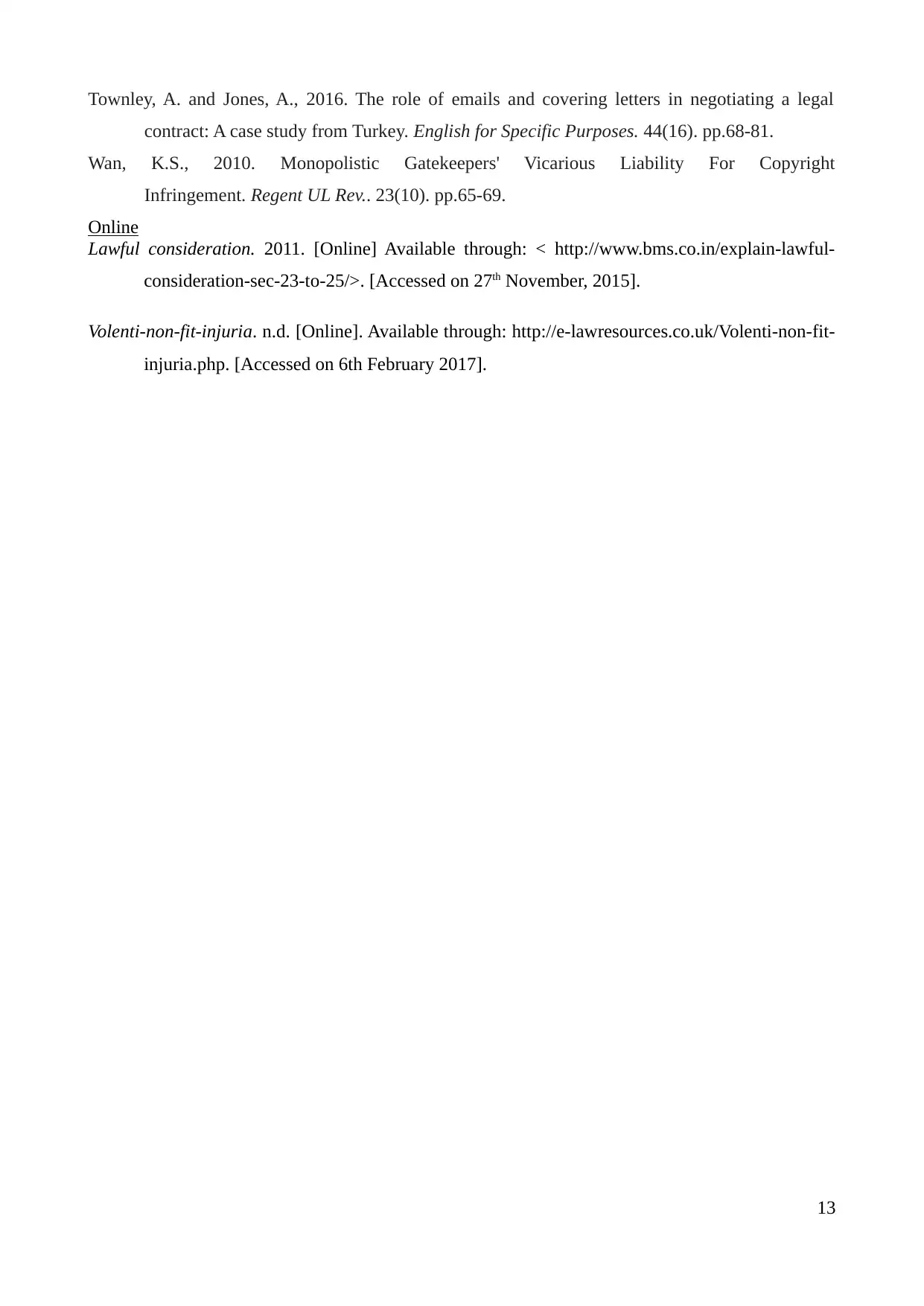
Townley, A. and Jones, A., 2016. The role of emails and covering letters in negotiating a legal
contract: A case study from Turkey. English for Specific Purposes. 44(16). pp.68-81.
Wan, K.S., 2010. Monopolistic Gatekeepers' Vicarious Liability For Copyright
Infringement. Regent UL Rev.. 23(10). pp.65-69.
Online
Lawful consideration. 2011. [Online] Available through: < http://www.bms.co.in/explain-lawful-
consideration-sec-23-to-25/>. [Accessed on 27th November, 2015].
Volenti-non-fit-injuria. n.d. [Online]. Available through: http://e-lawresources.co.uk/Volenti-non-fit-
injuria.php. [Accessed on 6th February 2017].
13
contract: A case study from Turkey. English for Specific Purposes. 44(16). pp.68-81.
Wan, K.S., 2010. Monopolistic Gatekeepers' Vicarious Liability For Copyright
Infringement. Regent UL Rev.. 23(10). pp.65-69.
Online
Lawful consideration. 2011. [Online] Available through: < http://www.bms.co.in/explain-lawful-
consideration-sec-23-to-25/>. [Accessed on 27th November, 2015].
Volenti-non-fit-injuria. n.d. [Online]. Available through: http://e-lawresources.co.uk/Volenti-non-fit-
injuria.php. [Accessed on 6th February 2017].
13
1 out of 13
Related Documents
Your All-in-One AI-Powered Toolkit for Academic Success.
+13062052269
info@desklib.com
Available 24*7 on WhatsApp / Email
![[object Object]](/_next/static/media/star-bottom.7253800d.svg)
Unlock your academic potential
© 2024 | Zucol Services PVT LTD | All rights reserved.





